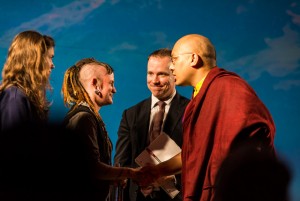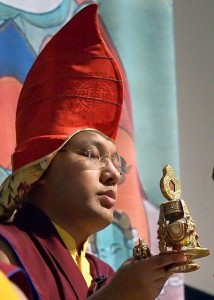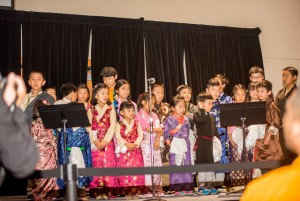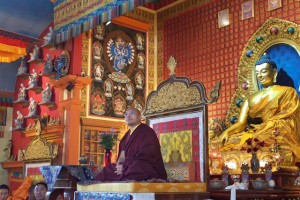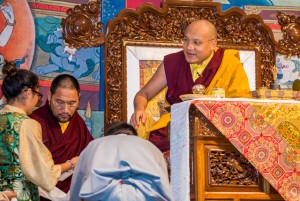Saturday, January 22, 2000
KARMAPA Ogyen Trinley Dorje heads the Kagyu tradition which occupies an important place among the five principal spiritual traditions of Tibet.
The 17th Karmapa: In the eye of a politico-religious stormThis tradition has remained strong and successful due to the presence of an unbroken line of reincarnations of the founder, the successive Karmapas.
The lineages of the Kagyu school of Tibetan Budhism derive primarily from two sources. Marpa Chokyi Lodoe (1012-1099) and Khyungpo Nyaljor (978-1079). The former was trained as a translator by Drogmi Yeshe (993-1050) and then travelled three times to India and four times to Nepal in search of religious teachings.
Marpa brought the four commissioned lineages of tantrik teachings, including the illusory body and consciousness transference, dreams, clear light and inner heat to Tibet and passing them on to his foremost disciple Milarepa (1040-1123), the most celebrated and accomplished of Tibet’s tantrik yogis, who achieved the ultimate goal of nirvana in one lifetime.
Marpa brought the four commissioned lineages of tantrik teachings, including the illusory body and consciousness transference, dreams, clear light and inner heat to Tibet and passing them on to his foremost disciple Milarepa (1040-1123), the most celebrated and accomplished of Tibet’s tantrik yogis, who achieved the ultimate goal of nirvana in one lifetime.
The Dakpo Kagyu, the mother lineage of the Kagyu tradition, gave rise to four major schools founded by the disciples of Gampopa who also pioneered a fusion of Milarepa’s Mahamudra tradition with the stages of the path tradition of the Kadampa order.
The training of monks in Kagyu monasteries consists mainly of the study of perfection of wisdom, madhyamika, valid cognition, discipline and phenomenology common to all traditions, except that each tradition has its own monastic texts and commentaries to facilitate understanding of the original Indian texts.
The other Tibetan traditions are, the Bonpo, the Sakya, the Gelug and the Nyingma.
The Karma Kagyu was founded by the first Karmapa, Dusum Khyenpa (1110-1193). Famous among the successive Karmapas were the second Karmapa, Pakshi (1206-1282), the third Karmapa, Ranjung Rigpe Dorjey (1284-1339) and the eighth Karmapa Mikyo Dorjey (1507-1554).
The predecessor of the present Karmapa was the sixteenth Karmapa, Ranjung Rigpe Dorjey (1924-81), who in exile was also appointed head of the Kagyu tradition.
The Tsurphu monastery in the Central Tibet was the main monastery of this tradition. But after coming into exile, the tradition has re-established its headquarters and principal monastic university at Rumtek in Sikkim. During the absence of the Gyalwa Karmapa’s incarnation, four high lamas, who were his disciples were acting as regents. They are Shamar Rinpoche, Gyaltsab Rinpochey, Situ Rinpochey and Jamgon Kongtrul Rinpoche.
Bon is the oldest spiritual tradition of Tibet, while the sakya tradition is closely bound up with the Khon ancestral lineage, which derived from celestial beings.
The Gelug tradition has remained dynamic even after coming into exile. The tradition was founded by Je Tsongkhapa (1357-1419). The major Relug monasteries, Sera, Drepung, Ganden and Tashi Ihunpo and Gyumey Tantric College have been re-established in various Tibetan settlements in Karnataka and the Gyuto Tantric College has been re-established at Bomdill, Arunachal Pradesh.
The Nyingma School of Tibetan Buddhism too has its origin to the Indian adept, Guru Padamsambhava, who came to Tibet on the invitation of king Trisong Deutsan (742-797) in order to curb the evil forces then impeding the spread of Buddhism.
Reincarnation story retold
By Pratibha Chauhan
THE Chinese design to divide the Tibetan community in-exile by fostering discord between the rival contending sides over the issue of the real reincarnate of the 16th Karmapa appears to be succeeding to a certain extent.
A fresh controversy has been raked up about who the legitimate Karmapa is ever since the escape of Ogyen Trinley Dorjee to Mcleodganj, the headquarters of the Tibetan government-in-exile. There had been a bitter controversy over the issue of the real Karmapa, the head of the Kagyu sect of Tibetan Buddhism, even in 1994. The problem was serious enough to cause a political crisis and police had to be posted outside the wealthy and powerful Rumtek monastery in Sikkim, to maintain its sanctity.
Ogyen Trinley Dorjee was enthroned as the head of the Kagyu sect, on September 27, 1992, at Tsurphu monastery, the main seat of all gyalwa Karmapas. Tai Situ Rinpoche and Goshir Gyaltsab Rinpoche had been instrumental in the selection of Trinley as the 17th Karmapa. Even the Tibetan spiritual leader, Dalai Lama, confirmed Trinley as the reincarnate of the 16th Karmapa, Rangjung Rigpe Dorjee, who died in 1981 in Chicago.
It was for the first time that the Chinese, too, recognised a reincarnate, a theory which they do not believe in. Trinley was accepted as the 17th Karmapa by the communist regime in Beijing.
Shamarpa Rinpoche, another regent of the Kagyu sect, has put forward the name of Thaye Dorji as the real incarnate of the 16th Karmapa. He has threatened that Trinley, who is also the choice of the Dalai Lama, shall not be accepted by the monks at the Rumtek monastery in Sikkim. As if this feud was not enough, a third contender in Sikkim — Dewa Sangpo Dorji — emerged, posing a challenge to the other two candidates for the post.
Since so much wealth and power is at stake, choosing a new ‘Grand Lama’ or the reincarnate has always been a tricky affair. Even the selection of the Dalai Lama has never been smooth or uneventful and many of the earlier spiritual leaders disappeared mysteriously or died in suspicious circumstances. The fifth Dalai Lama, Lobsang Gyatso, was the first to wield both religious and temporal power over Tibet and all Tibetans acknowledged him as the supreme pontiff of the country.
The tradition of the reincarnation is a peculiar feature of Vajrayana. It is connected with the concept of bardo, the intermediate period between birth and rebirth. It is believed that death is only a pause in the continuity of birth and rebirth. A Bodhisatva lives and dies and is reborn solely with the intent to liberate beings from ignorance and confusion. For him a past and present is manifest in the present, therefore he surpasses the space continuum.
As a religious head passes away, reincarnations are born, identified, enthroned, instructed and empowered until they in turn become masters. There have been enlightened, reincarnated in the case of the Dalai Lama, Panchen Lama and the Karmapa, the head of the Kagyus sect.
Some reincarnations are identified through dreams, some through the vision of holy persons, some through the instructions left at the time of the death, some through auspicious signs of nature and some have simply proclaimed their identity while still being infants. Some of the reincarnates are put through the test of identifying the objects belonging to the previous incarnate.
There are no rigid rules for the process of identification. There have been incarnates who have been princes, while others were cow herds. The only guiding principle for such birth is compassion of the Bodhisatvas and the collective karma of the people.
Just as there are no rigid patterns to the process of identifying a reincarnate, there is also no set form as to who should identify a reincarnate. Normally a high tulku or incarnate Rinpoche recognises and identifies the new reincarnate, who belongs to his monastery. Often, there have been cases when a great reincarnate has been identified by a single pure Lama or even by emissaries and representatives, of the Rinpoches and the tulkus.
Soon after a tulku or reincarnate is identified, he is enthroned and provided with the best instructors. At times they go through difficult phases. They have to find an instructor who accepts them and finally they are given instructions on dharma by the guru. After an year of hardship and toil, he has access to the vast ocean of dharma and is surrounded by great masters.
A special boy
It has become clear at the time of the birth of Ogyen Trinley Dorjee that he was a "special boy", who was an incarnate of a high Lama.
On the day of his birth on June 26, 1985, the villagers reported hearing the sound of conch shells for an hour, followed by another musical sound, the source of which could not be found. Perhaps, the most dramatic of the many signs were the three suns, which shone in the sky. Seen by all present, they were of the same size and appeared in a row. Over the middle sun, arched a rainbow, each end of which dissolved suns on the sides.
This strange phenomenon was reported throughout eastern Tibet, as if clearly signified the arrival of a reincarnate. After seeking the blessing and help of many Lamas, Karma Dhondup and his wife Loga were blessed with this boy. As promised by the parents, the boy was taken to the Kalek monastery, and installed as a tulku, though he was not given a name, Khatza Tapa, a local wise man proficient in mirror medicine, made a prediction when he saw a conch shell spiralling clockwise: "The boy will greatly benefit beings. When he is eight years old everything will be clear, but until then no one can confirm who he is".
In the tradition of the Karmapas, Rangjung Rigpe Dorje, the 16th Karmapa, had predicted his successor by writing a sacred letter, disclosing his incarnation. In this letter he is learnt to have specified the time and circumstances of his birth, the name of his parents and the location where he could be found, written six months before his death, in 1981, the 16th Karmapa, had hidden this letter in a talisman, given to Tai Situ Rinpoche. Since the Rinpoche did not know of the secret, it stayed hidden until he opened the amulet many years later and discovered the sacred letter of prediction.
The search party found that the description in the letter was very clear and exact. It said: In the east of Tibet (Kham), in a nomadic community with the sign of the cow (Barkor — the name of the birthplaces is an old Tibetan word for cow), the method (the father) is Dondrup, and the wisdom (the mother) is Loga.
The process of discovering the Karmapa began in the spring of 1992. Copies of the letter of prediction were sent to Drupon Dechon Rinpoche at Tsurphu monastery in Tibet along with its interpretation. A search party was dispatched by Tai Situ Rinpoche and Gyaltsab Rinpoche. The party comprising Akong Rinpoche and Sherab Tarchin finally arrived at Kalek monastery, where the special boy had been a monk since the age of four. On the day the search party arrived, the Karmapa awoke early and said, "My monks are coming and I am ready to go to the monastery.
Without giving any explanation to his parents, he had insisted, several weeks earlier, that they move to the spring pasture one month ahead of schedule. Due to this, the family was at the exact place the 16th Karmapa had predicted in his letter. The search party was able to find them without any trouble. The members of the search party had already heard about miraculous events from locals before reaching the dwelling place of the Karmapa’s parents. The conch shell music was also predicted by the 16th Karmapa in his letter.
Fully convinced, Lama Domo, head of the search party gave the father a copy of the sacred letter, and it was then that Karma Dondrup realised with certainty that his son was the reincarnation of the 16th Karmapa, later, the Tsurphu monastery informed Tai Situ Rinpoche and Gyaltsab Rinpoche and finally the Dalai Lama was informed about the discovery of the reincarnate of the 16th Karmapa.
Finally on September 27, 1992, Ogyen Trinley Dorjee was enthroned at the Tsurphu monastery, the seat of the Gyalwa Karmapas.


